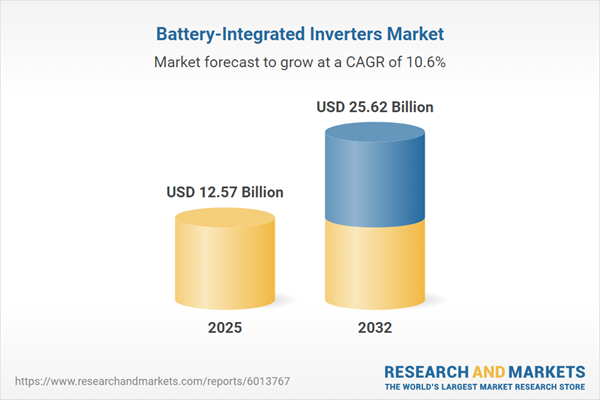Speak directly to the analyst to clarify any post sales queries you may have.
Battery-integrated inverters are shaping a new era of energy resilience, providing a crucial interface between renewable generation and stable, responsive power distribution. For senior decision-makers seeking reliable growth opportunities in sustainable infrastructure, understanding developments in this sector is essential.
Market Snapshot: Battery-Integrated Inverters Market Growth Drivers
The battery-integrated inverters market grew from USD 11.44 billion in 2024 to USD 12.57 billion in 2025. It is projected to maintain a robust CAGR of 10.60%, reaching USD 25.62 billion by 2032. Market momentum is driven by increasing demand for operational flexibility, renewable energy integration, and the need for enhanced grid stability. Senior executives are focusing on solutions that offer real-time insights, remote monitoring, and advanced control to optimize costs and mitigate risks associated with fluctuating energy resources.
Scope & Segmentation: Comprehensive Industry and Technology Breakdown
- Type: Single-phase battery-integrated inverters, Three-phase battery-integrated inverters
- Battery Chemistry: Lead acid (flooded, VRLA), lithium-ion (iron phosphate, nickel manganese cobalt, nickel cobalt aluminum oxide), nickel-cadmium
- Inverter Topology: Central, micro, string
- Capacity Range: Below 100 kW, 100-500 kW, above 500 kW
- Installation Type: Off grid, on grid
- Application: Commercial, industrial, residential, utility
- Geography: Americas (United States, Canada, Mexico, Brazil, Argentina, Chile, Colombia, Peru), Europe, Middle East & Africa (United Kingdom, Germany, France, Russia, Italy, Spain, Netherlands, Sweden, Poland, Switzerland, UAE, Saudi Arabia, Qatar, Turkey, Israel, South Africa, Nigeria, Egypt, Kenya), Asia-Pacific (China, India, Japan, Australia, South Korea, Indonesia, Thailand, Malaysia, Singapore, Taiwan)
- Companies Analyzed: Including Alpha ESS Co., Ltd., Blue Planet Energy Systems LLC, FIMER S.p.A., Huawei Technologies Co., Ltd., Schneider Electric Solar Inverters USA, Inc., SMA Solar Technology AG, SolarEdge Technologies, Inc., and others
Key Takeaways: Strategic Insights for Senior Executives
- Battery-integrated inverters are central to enabling efficient grid balancing, bidirectional energy flows, and effective management of renewable intermittency.
- Emerging control algorithms and digital communication platforms support predictive maintenance, resulting in reduced system downtime and improved asset reliability.
- Global regulatory trends, including decarbonization mandates and new grid codes, are accelerating adoption, prompting manufacturers to align product features with evolving standards.
- Segmented solutions address varied end-user needs, from high-density residential applications favoring compact units to industrial and utility environments demanding enhanced scalability and robust safety features.
- Turnkey solutions combining advanced battery chemistry with intelligent inverters are gaining traction, as project developers and utilities emphasize long-term value.
- Strategic partnerships, digitalization, and localized manufacturing initiatives are redefining competitive dynamics across key regions.
Tariff Impact: Considerations for U.S. Policy Changes
Revised United States tariff schedules for 2025 affect core inverter components, including semiconductor, power electronic modules, and battery cells. Resulting procurement cost increases may prompt suppliers to reevaluate sourcing strategies, potentially shifting assembly closer to domestic markets. Project stakeholders may adjust pricing or expedite adoption of alternative chemistries. Proactive engagement with regulatory bodies and supplier diversification are recommended for resilience in procurement and supply chain management.
Methodology & Data Sources: Rigorous Validation Process
This research utilizes systematic desk analysis, expert interviews, and triangulation of quantitative and qualitative data. Carefully structured interviews with technology providers and utilities supplement industry desk research, ensuring integrity across performance, regulatory, and market adoption insights.
Why This Report Matters: Actionable Value for Decision-Makers
- Equips leaders with intelligence on evolving technology drivers, regulatory shifts, and regional growth patterns for effective strategic planning.
- Identifies critical procurement risks and new value propositions, supporting optimal investment and market expansion decisions.
- Provides detailed segmentation to guide product development, partnerships, and market entry strategies with tailored recommendations.
Conclusion
The battery-integrated inverters market is evolving through technical innovation, regulatory change, and dynamic regional demand. Executives who proactively align with market and policy shifts will strengthen their position, accelerate adoption, and support robust, resilient energy systems.
Additional Product Information:
- Purchase of this report includes 1 year online access with quarterly updates.
- This report can be updated on request. Please contact our Customer Experience team using the Ask a Question widget on our website.
Table of Contents
3. Executive Summary
4. Market Overview
7. Cumulative Impact of Artificial Intelligence 2025
Companies Mentioned
The companies profiled in this Battery-Integrated Inverters market report include:- Alpha ESS Co., Ltd.
- Blue Planet Energy Systems LLC
- Ampere Energy, S.L.
- Bosch Power Tec GmbH
- Delta Electronics, Inc.
- Eguana Technologies Inc.
- Enphase Energy, Inc.
- FIMER S.p.A.
- Ginlong Technologies Co., Ltd. (Solis)
- GoodWe Technologies Co., Ltd.
- Growatt New Energy Technology Co., Ltd.
- Huawei Technologies Co., Ltd.
- Hybrid Power Solutions Inc.
- KACO new energy GmbH
- Midnite Solar, Inc.
- Northern Electric Power Technology Inc.
- OutBack Power Technologies, Inc.
- Portable Solar, LLC
- Pylon Technologies Co., Ltd.
- Redback Technologies Pty Ltd.
- Schneider Electric Solar Inverters USA, Inc.
- SENEC GmbH
- Shenzhen Lux Power Technology Co., Ltd.
- SMA Solar Technology AG
- SolarEdge Technologies, Inc.
Table Information
| Report Attribute | Details |
|---|---|
| No. of Pages | 180 |
| Published | November 2025 |
| Forecast Period | 2025 - 2032 |
| Estimated Market Value ( USD | $ 12.57 Billion |
| Forecasted Market Value ( USD | $ 25.62 Billion |
| Compound Annual Growth Rate | 10.6% |
| Regions Covered | Global |
| No. of Companies Mentioned | 26 |









